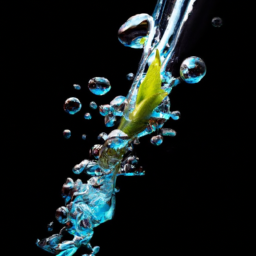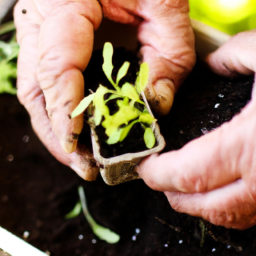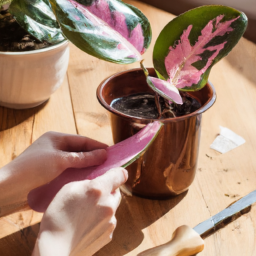
Have you ever wondered how to propagate plants in water? Propagating in water is a popular method for growing new plants from cuttings, and it’s easier than you might think. Whether you’re a beginner looking to expand your plant collection or a seasoned gardener wanting to try something new, propagating in water can be a fun and rewarding process. In this blog post, we’ll explore the ins and outs of propagating in water, including the best plants to propagate this way, tips for success, and more. So grab your favorite cutting shears and get ready to dive into the wonderful world of water propagation!
Benefits of Propagating Plants in Water
Introduction
When it comes to propagating plants, there are several methods you can choose from. One popular method that many plant enthusiasts swear by is propagating plants in water. This method involves placing plant cuttings in a container of water until roots develop, allowing the plant to establish itself before being transferred to soil. In this article, we will explore the benefits of propagating plants in water and provide a step-by-step guide on how to do it successfully.
Increased Success Rate
One of the main benefits of propagating plants in water is the increased success rate compared to other methods. When you propagate plants in water, you are able to closely monitor the development of roots, ensuring that they are healthy and strong before transplanting the cutting into soil. This method also reduces the risk of transplant shock, as the plant has already established a healthy root system in water before being moved.
Additionally, propagating plants in water allows you to easily identify any issues that may arise during the rooting process. If a cutting is not developing roots as expected, you can quickly make adjustments to the water or cutting to encourage root growth. This level of control and visibility can greatly increase the chances of successful propagation.
Another advantage of propagating plants in water is that it is a clean and mess-free process. Unlike soil propagation, there is no need to worry about soil-borne diseases or pests affecting the cutting. Water propagation also eliminates the need for messy potting soil, making it a convenient option for indoor propagation.
Cost-Effective and Sustainable
Propagating plants in water is a cost-effective and sustainable method of plant propagation. Instead of purchasing new plants or seeds, you can simply take cuttings from existing plants and propagate them in water. This not only saves money, but it also allows you to expand your plant collection without contributing to environmental waste.
Water propagation also reduces the need for plastic pots and soil, making it a more sustainable option for plant propagation. By using reusable containers and water, you can minimize your environmental impact and promote a more eco-friendly approach to gardening.
In addition, propagating plants in water can be a fun and rewarding experience. Watching roots develop and seeing a new plant grow from a cutting can be a gratifying process that connects you more closely to nature. This hands-on approach to plant propagation can deepen your appreciation for plants and foster a greater sense of stewardship for the environment.
In conclusion, propagating plants in water offers numerous benefits, including increased success rates, cost-effectiveness, sustainability, and a rewarding experience. By following the step-by-step guide provided in this article, you can successfully propagate plants in water and enjoy the many advantages that this method has to offer. Happy propagating!

Techniques for Propagating Aquatic Plants in Water
As an expert in propagating aquatic plants in water, I am excited to share with you some techniques that will help you successfully grow and propagate your favorite aquatic plants. Propagating plants in water can be a fun and rewarding experience, and with the right techniques, you can easily expand your collection of aquatic plants.
Choosing the Right Plants
Before you start propagating aquatic plants in water, it is important to choose the right plants for your setup. Some aquatic plants are easier to propagate in water than others, so it is important to do some research and select plants that are known to thrive in a water propagation environment. Some popular choices for water propagation include Java fern, Anubias, and water lettuce.
When selecting plants for water propagation, it is also important to consider the size of your container and the amount of light it receives. Some aquatic plants require more light than others, so be sure to choose plants that are compatible with the lighting conditions in your setup.
Once you have chosen the right plants for water propagation, you can begin the process of propagating them in water. Here are some techniques that will help you successfully propagate aquatic plants in water:
Preparing the Container
Before you start propagating aquatic plants in water, it is important to prepare a suitable container for them to grow in. The container should be clean and free of any debris or contaminants that could harm the plants. You can use a glass jar, a plastic container, or any other vessel that is large enough to hold the plants and allow them to grow.
Fill the container with clean, dechlorinated water that is at room temperature. You can use tap water that has been treated with a water conditioner to remove any chlorine or other chemicals that could be harmful to the plants. Make sure the water level is sufficient to cover the roots of the plants, but not so high that the leaves are submerged.
Place the container in a location where the plants will receive adequate light. Aquatic plants require light to photosynthesize and grow, so it is important to place the container in a well-lit area. You can use a grow light if natural light is not available, but be sure to monitor the plants closely to ensure they are not getting too much light.
Propagating the Plants
Once you have prepared the container, you can begin propagating the aquatic plants in water. There are several methods you can use to propagate aquatic plants, including division, cuttings, and runners. Each method has its own advantages and disadvantages, so it is important to choose the method that is best suited to the plant you are propagating.
Division is a common method of propagating aquatic plants in water. To propagate plants by division, simply separate a healthy portion of the plant from the main plant and place it in the container of water. Be sure to trim any damaged or dead roots before placing the plant in the water, as this will help the plant establish itself more quickly.
Another method of propagating aquatic plants in water is by taking cuttings. To propagate plants by cuttings, simply cut a healthy portion of the plant from the main plant and place it in the container of water. Be sure to remove any leaves that will be submerged in the water, as this can cause the leaves to rot and harm the plant.

Common Mistakes to Avoid When Propagating in Water
Propagating plants in water can be a fun and rewarding experience, but there are some common mistakes that beginners often make. By avoiding these pitfalls, you can increase your chances of success and enjoy watching your plants thrive. Here are some common mistakes to avoid when propagating in water:
Not Using Clean Water
One of the most important factors in successful water propagation is using clean water. Tap water can contain chemicals like chlorine and fluoride that can be harmful to plants. It’s best to use filtered or distilled water to ensure that your plants have the best chance of rooting successfully. Additionally, make sure to change the water regularly to prevent the growth of algae and bacteria, which can also harm your plants.
When changing the water, gently rinse the roots of your plant to remove any debris or buildup. This will help keep the water clean and ensure that your plant has access to the nutrients it needs to grow strong and healthy. By using clean water and changing it regularly, you can avoid one of the most common mistakes in water propagation.
Another tip is to avoid using water that is too cold or too hot. Room temperature water is best for most plants, as extreme temperatures can shock the roots and hinder growth. By paying attention to the temperature and quality of the water you use, you can set your plants up for success from the start.
Choosing the Wrong Plant
Not all plants are well-suited for water propagation, so it’s important to choose the right plant for this method. Some plants, like pothos and philodendron, root easily in water and are great choices for beginners. Other plants, like succulents and cacti, are not well-suited for water propagation and may rot if left in water for too long.
Before starting the propagation process, do some research on the specific plant you want to propagate to determine if it is a good candidate for water propagation. Look for plants with nodes or aerial roots, as these are indicators that the plant will root well in water. By choosing the right plant for water propagation, you can avoid the frustration of trying to propagate a plant that is not well-suited for this method.
Additionally, make sure to use healthy plant cuttings for propagation. Avoid using cuttings that are diseased or damaged, as these will not root well and may introduce pests or diseases to your water propagation setup. By choosing the right plant and using healthy cuttings, you can increase your chances of success and enjoy watching your plants thrive.
Overlooking Rooting Hormones
Rooting hormones can be a helpful tool in water propagation, especially for plants that are more difficult to root. These hormones stimulate root growth and can help your plant establish a strong root system more quickly. However, many beginners overlook the use of rooting hormones and miss out on the benefits they can provide.
When using rooting hormones, make sure to follow the instructions on the packaging carefully. Dip the end of your cutting in the hormone before placing it in water, and avoid using too much, as this can actually hinder root growth. Rooting hormones are not necessary for all plants, but they can be a useful tool for increasing the success rate of your water propagation efforts.
Another tip is to use a rooting hormone that is specifically formulated for water propagation. These hormones are designed to dissolve easily in water and are less likely to cause issues with water quality. By using rooting hormones correctly and choosing the right type for water propagation, you can give your plants a head start in establishing strong roots and thriving in their new environment.
Crisp Recap
Propagating plants in water is a simple and effective way to grow new plants from cuttings. All you need is a glass or jar filled with water, and a healthy plant cutting. Simply trim a few inches of stem from a healthy plant, remove any leaves from the bottom few inches, and place the cutting in the water. Make sure to change the water every few days to prevent bacteria buildup and keep the cutting healthy.
Water propagation is a great way to watch roots grow before transferring the cutting to soil, and it’s a fun and rewarding way to expand your plant collection. Many plants can be propagated in water, including pothos, spider plants, and philodendrons. So next time you’re looking to add more greenery to your home, consider trying water propagation as a simple and cost-effective method to grow new plants.
Top FAQs:
Q1: Can all plants be propagated in water?
A1: Not all plants can be successfully propagated in water. Some plants, like succulents and cacti, are better suited for propagation in soil. However, many common houseplants, such as pothos, spider plants, and philodendron, can be easily propagated in water.
Q2: How do I propagate a plant in water?
A2: To propagate a plant in water, simply cut a healthy stem or leaf from the parent plant and place it in a container of water. Make sure to change the water regularly to prevent the growth of mold or bacteria. Roots should start to grow within a few weeks.
Q3: How long does it take for roots to grow when propagating in water?
A3: The time it takes for roots to grow when propagating in water can vary depending on the plant species. Some plants may develop roots in as little as a week, while others may take several weeks. Patience is key when propagating plants in water.
Q4: Can I leave my propagated plant in water indefinitely?
A4: While plants can survive in water for an extended period of time, it is not ideal to leave them in water indefinitely. Once roots have developed, it is best to transfer the plant to soil for long-term growth and health.
Q5: What are the benefits of propagating plants in water?
A5: Propagating plants in water can be a simple and effective way to expand your plant collection without the need for potting soil. It also allows you to easily monitor root growth and provides a visually appealing way to display your growing plants.
Dr. Olivia Green is a botanist with over two decades of experience in indoor plant cultivation. She holds a Ph.D. in Plant Biology and has dedicated her career to researching plant behavior in controlled environments. Dr. Green is passionate about helping plant enthusiasts master the art of indoor gardening through her extensive knowledge and practical insights.


